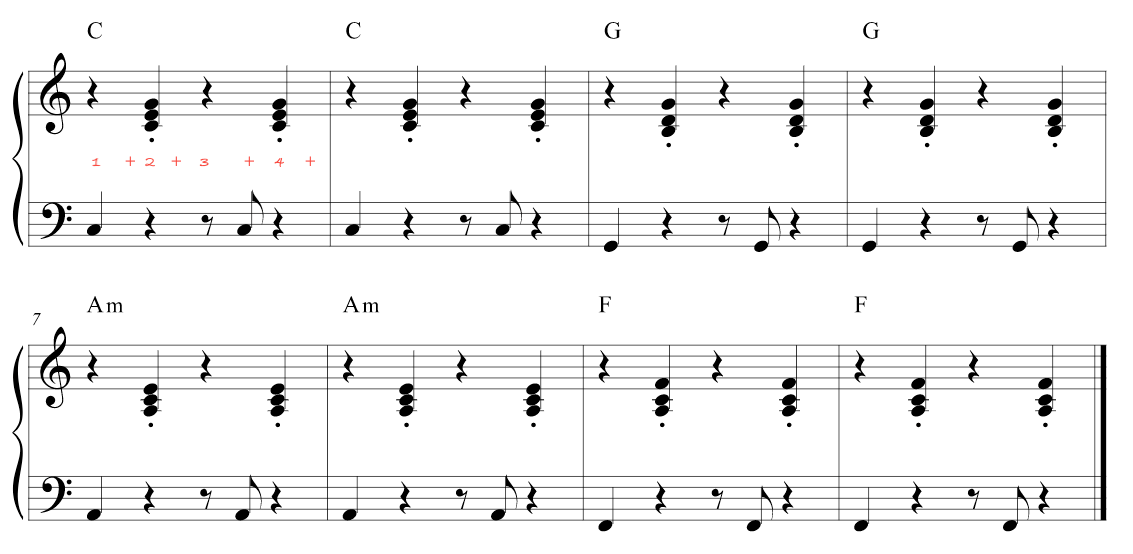We all get stuck in ruts. Where you find what’s comfortable and just … stick with it.
It’s natural. It’s easy. But it can also get boring. Especially when you find your left-hand is just playing the same thing over and over again.
Single notes. Maybe 5ths. Even octaves.
Not today. Today you’ll learn 3 left-hand piano rhythms that will shake things up, get you out of your comfort zone, so you’ll start sounding more sophisticated and professional.
You can take any of the 3 rhythms and put them in your favorite songs.
We’ll use a simple chord progression today. The most popular chord progression in pop music!
There are only 4 chords, but we will use some inversions to make it sound a little more musical.
If you don’t know what inversions are, check out that lesson. Or just play the chords in root position.
Here it is:
Four chords. All white keys, nice and simple. The point of this lesson is to focus on the rhythms, so we’ll keep the chords and notes very basic.
And if rhythm is brand new to you (or something you’ve always struggled with), then Dave from Drumeo has some awesome tips on how to work on your rhythms skills.
The first of our left-hand piano rhythms uses some off-beat notes to create movement and excitement in an otherwise simple and bland chord progression.

As you can see, the left-hand plays on the 1st and 3rd beat of each bar. But the tricky part is the eighth notes.
It really helps to count out these beats. Every bar has 4 quarter-note beats, which means there are 8 eighth-note beats.
To count this, we say ”One, and, two, and, three, and four.” So each number is on a quarter note, and each “and” is the eighth-note in between. Like this:

Count it out for yourself. Take it slow. This looks simple on paper, and it might even sound simple to you, but getting that coordination between your hands can take time.
So be kind to yourself. And don’t be afraid to write on your music to help you remember where the beats fall!
This one is more upbeat and cheerful, but it’s a little more complex in the left-hand.
Just like the first pattern, it really helps to take it slow and count this one out.

Counting helps you figure out when to play the notes. But once you have that in your mind, I’d also really encourage you to try and “feel” the rhythm more than rigidly counting it out each time.
Be patient and give yourself as much time as you need.
Another helpful tip is to LISTEN.
I find it’s the best way to get a rhythm into my head. So try listening to me playing it in the video and clap/count/tap along.
This is a little bit different, but if you’ve ever played classical music (or want to) then this pattern is super useful.
It’s an arpeggio pattern that uses a very similar pattern to an Alberti bass line.
And because the left-hand is more complicated here I’ve kept the right-hand to single notes.

If that right-hand is too easy, you’re free to explore some other options. I like adding chords to the pattern to really fill out the sound.
This left-hand pattern sounds so beautiful in so many different styles of music. I’d really encourage you to try it with some of your favorite songs.
Changing the rhythm is one of the easiest and most fun ways to completely switch up the sound of a song.
These left-hand piano rhythms will give you some things to explore and may present some new challenges.
But try them out, add them to your repertoire and add some pizzazz to your playing!
Lisa Witt has been teaching piano for more than 20 years and in that time has helped hundreds of students learn to play the songs they love. Lisa received classical piano training through the Royal Conservatory of Music, but she has since embraced popular music and playing by ear in order to accompany herself and others. Learn more about Lisa.
/marketing/pianote/promos/april/banner-bg-m.webp)
We use cookies for traffic data and advertising. Cookie Policy »
/marketing/pianote/promos/april/banner-title.webp)